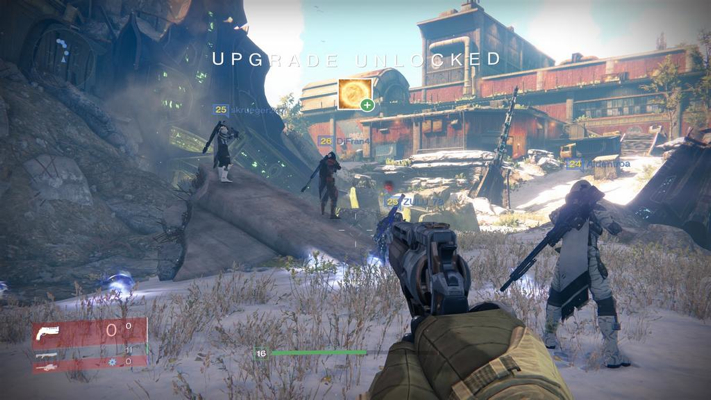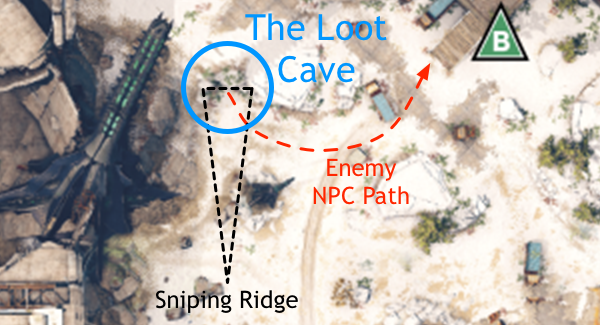
“The social experience of a cave farming run is amazing: the herding to get a team of Guardians all behind the line and firing in the right direction, the rush to grab the loot, the scramble when the panic wave starts, the beckoning glow from inside the cave. The speed at which the community organized around this activity was inspiring and humbling to us.”
Destiny’s loot cave is a fascinating phenomenon that has captured the interest of many journalists, critics and players. From a design perspective, it’s a potent example of emergent gameplay: the often unpredictable consequences that arise from complex interactions between individual game mechanics. I’d like to examine the details of how the loot cave works, speculate why it was difficult for Bungie to anticipate, and examine several options for fixing it.
The infamous cave is found in the Skywatch area of Destiny’s Old Russia level. The site would be unremarkable except for the gangs of high level players who (used to) hang out nearby. However, its unique geometry and the NPCs’ interactions with it are the key to what affords this particular exploit. The cave is a spawn point for low level Acolytes and Thralls, and its deep concave structure seems designed to obscure their reappearance from the player’s view. Once spawned, these creatures charge directly towards their intended combat zone on top of a nearby hill, disregarding incoming fire while in transit.
In Destiny, enemy NPCs are blocked from respawning if a player is nearby. However, the rolling hills that face this area allow players to see into the cave from a great distance. This means that player can stand outside of the range that would prevent respawning, while still firing into the cave with long-range rifles. Appearing under the player’s scope within a confined space and immediately charging towards the cave mouth, the enemies can be mown down over and over with ease.
This exploitative cycle is somewhat fragile, as it depends on the players’ ability to contain the flood of respawning NPCs within the bottleneck at the mouth of the cave. If an inopportune reload or lapse in concentration allows an enemy to escape the cave, the NPC can run free towards its destination and out of view of the ridge of snipers. Each enemy that escapes reduces the number that are spawning within the cave, diminishing the drop rate. A single player would therefore have great difficulty sustaining the loot cave; it requires two or more high level players diligently concentrating their fire. Given its reliance on the unspoken cooperation of strangers, it’s not surprising that Bungie was unable to anticipate this unusual tactic.

Why would high level players opt to use this repetitive tactic, rather than participate in advanced missions as the developers intended? Firstly, there’s the unusual decision by Bungie that any NPC is eligible to drop legendary weapons and armour, even enemies that are significantly lower level than the player. Secondly is the fact that Destiny’s loot system is notoriously stingy. In the recent developer notes, Bungie had acknowledged the fact that their high level encounters and daily missions lack fanfare when loot is obtained. Furthermore, many of their systems offer faction reputation as a reward, an abstraction from the loot itself that may be difficult for players to grasp. It’s therefore understandable why some would prefer the tangible rewards and strong shiny feedback of the loot cave.
We can further examine the loot cave through the MDA framework, where mechanics describe the formal rules of the game, dynamics describe the rules acting in concert and responding to player input, and aesthetics describe the player’s experience of the game. Through this lens, the loot cave interaction looks like this:
- Mechanic: NPC respawn points are blocked by proximity, but not line of sight.
- Mechanic: Individual NPCs in Skywatch respawn 6 seconds after dying.
- Mechanic: Any NPC can drop legendary items regardless of level.
- Mechanic: Advancement beyond level 20 is only possible through gear.
- Mechanic: Ambient multiplayer allows players to meet up randomly.
- Dynamic: The Loot Cave™
- Aesthetic: Periodic excitement from loot drops, boredom from repetition.
Last Thursday, roughly a week after being widely discovered, Bungie published a small hotfix to greatly decrease the efficiency of farming the loot cave. This was accomplished by “normalizing” the NPC respawn timers in Skywatch to 40 seconds, stymying the endless flood of monsters and effectively ending this particular instance of the loot cave phenomenon. However, the community has quickly identified new locations with a similar farming dynamic.
Bungie could continue to hotfix respawn timers, but in aggregate that might have the unintended effect of emptying out low-level patrol areas. They could prevent weak monsters from dropping legendary gear, but that might make much of their world obsolete to players past level 20. Ultimately, I think Bungie is already planning systemic changes in the right direction: making their existing end-game content more rewarding. If the strike & raid missions find an appropriate balance of difficulty, reward and fanfare, then players might stop hunting for a cave to shoot into.




